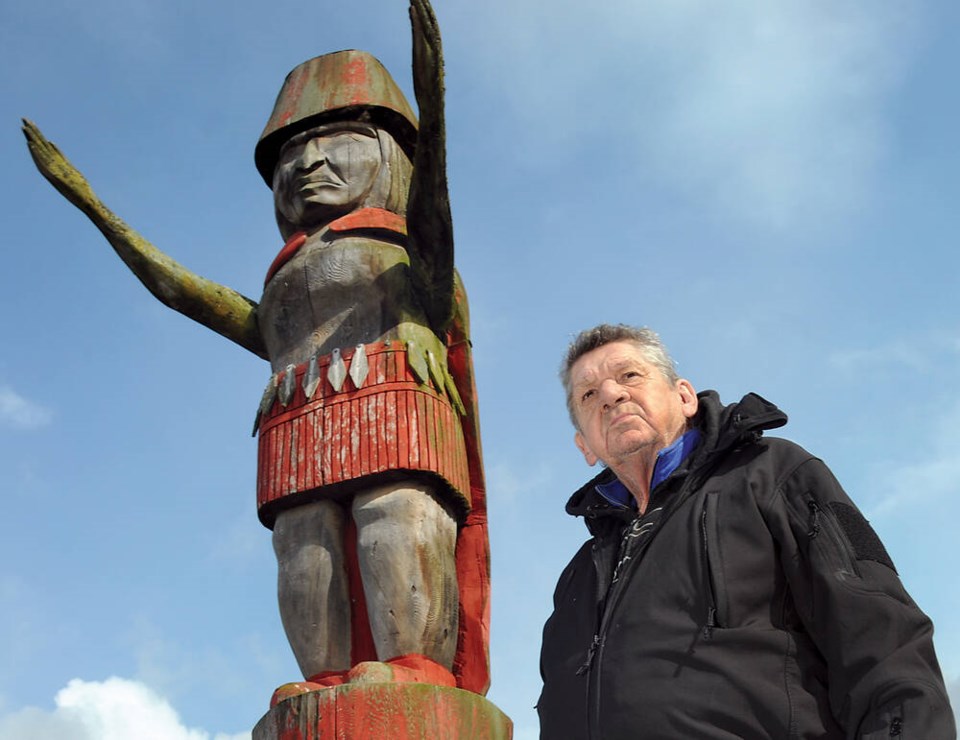A delicate restoration process is in the works for Ambleside’s Welcome Figure totem pole, one of West Vancouver’s most iconic landmarks and a masterpiece of Sḵwx̱wú7mesh Úxwumixw (Squamish Nation) master carver and elder Sequiliem (Stan Joseph).
The eight-week project, funded with $50,000 from District of West Vancouver's Public Art Reserve Fund, will see the piece sanded, shaped, stripped, power washed and painted to restore it to its former glory.
Situated at the very end of Ambleside’s beach groyne, arms outstretched to Burrard Inlet, the soaring 16-foot carving is particularly exposed to the elements.
Weather damage has befallen the piece, with the cracks and peeling paint that has plagued it over the years only exacerbated by last year’s winter storms.
Joseph, who erected the figure in 2001 as a gift from the Nation, said the female figure totem has also fallen prey to local youth during its two decades of life.
Graffiti can be seen scrawled across its base. A number of the paddles that make up the figure’s crimson cedar dress – 16 in total to mark each of the Squamish reserves – have been broken off and stolen, an annual tradition for graduating university students, he said.
“I knew when I made it that I was going to have to restore it at some point,” said the carver, whose previous restoration projects include the Capilano Suspension Bridge totem poles, four large poles on the Xwemelch'stn (Capilano 5) Reserve, and poles for Seaspan.
Removing or adjusting the Welcome Figure’s position would bring the risk of “upsetting the sacred ground that it stands on,” so all restoration work will take place on site, he said.
Following the preliminary power washing and rough sanding, scaffolding will be erected so Joseph and his team – he’ll be leading a group of apprentices throughout – can fine sand, strip, and re-carve the back and face of the figure.
“Then we’re going to cold cure the whole thing to fill in the cracks,” he said.
Joseph will also carve and attach replacement paddles, apply new Lag bolts to the arms, and cap the figure with a metal plate on its top to preserve the wood.
“With what we’re planning to do this time around, the pole will be good for another 50 years, at least,” he said.
The restoration is no small feat, no less intricate than the initial creation project in 2001.
Joseph spent two months working on the female figure, painstakingly carving each detail from a 1,200-year-old cedar log taken from Hollyburn Mountain. Sections of the cedar – a female tree chosen for its lighter hue, Joseph said – were then dyed bright crimson with iron oxide, a natural dye used for spiritual protection.
Initially the beacon of welcome had incited shock from locals, Nation members and council alike – female totem figures were few and far between. Yet for Joseph, it was the most fitting form to welcome tourists and locals into the municipality.
“At the time when the [West Vancouver] committee came to me and asked if I had an idea for a welcome figure, I knew immediately it would be a grandmother. I’d never seen a grandmother figure in our coastal area before, but this made the most sense. Grandmothers are the most welcoming of people.”
Joseph recalled memories of his own grandma, forever welcoming him into her home with tea and biscuits. The traits of being warm and welcoming are consistent with grandmothers all over the world “no matter what colour or where they are from.”
“I’ve met grandmothers from different nations and different reserves, and they’re always very welcoming. That really hit me. Our grandmothers, our mothers, they need to be recognized. That’s why I chose this welcome figure, to bring respect to those all over the world,” he said.
Doti Niedermayer, senior manager of cultural services at West Vancouver, said the figure, with her outstretched arms, “welcomes and guides guests during their travels.”
Niedermayer said the pole has become an “important symbol of welcome and friendship” due to its location on the highly visited shores of West Van, and the decision to take whatever measure to restore and preserve it was a unanimous one from all members of West Vancouver council.
The unveiling of the restored pole is expected for mid-May, and will be celebrated with a ceremony open to all, said Joseph – Squamish Nation members, locals, and those guests simply passing through.
Mina Kerr-Lazenby is the North Shore News’ Indigenous and civic affairs reporter. This reporting beat is made possible by the Local Journalism Initiative.



